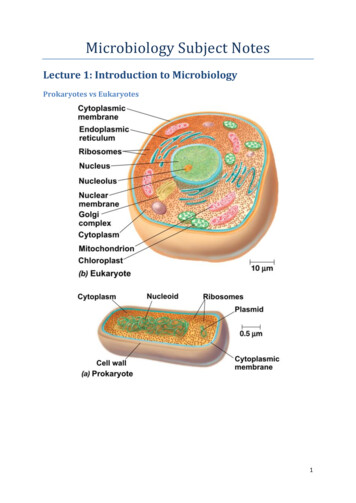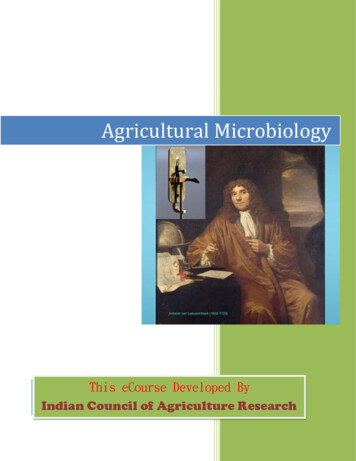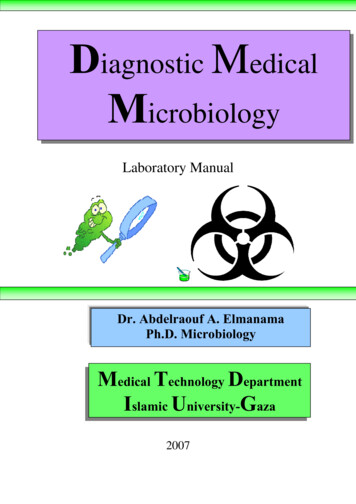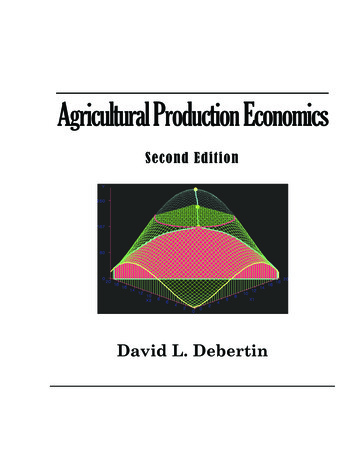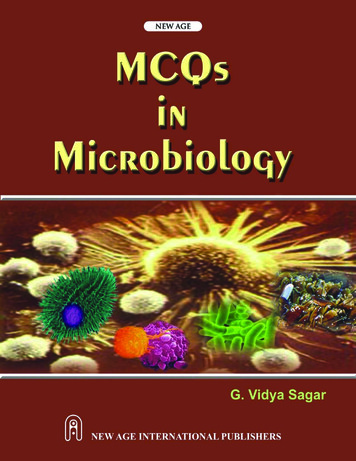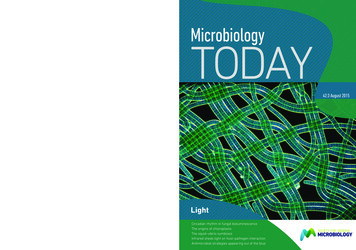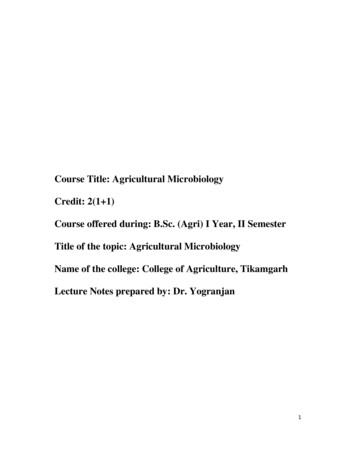
Transcription
Course Title: Agricultural MicrobiologyCredit: 2(1 1)Course offered during: B.Sc. (Agri) I Year, II SemesterTitle of the topic: Agricultural MicrobiologyName of the college: College of Agriculture, TikamgarhLecture Notes prepared by: Dr. Yogranjan1
Lecture NotesOnAgricultural Microbiology2
ContentsSyllabus of the course as per the recommendations of5the ICAR Fifth Deans ‘CommitteeChapter 1Introduction to microbiology6-191.1 Introduction71.2 Prokaryotic and Eukaryotic microorganisms81.3 Microbiology– in context to agriculture91.4 History of Microbiology13Chapter 2Bacteria: Structure, Classification, Nutrition and Growth20-332.1 Introduction212.2 Bacterial Size212.3 Bacterial Morphology212.4 Bacterial structure232.5 Growth and multiplication of bacteria302.6 Nutritional diversity in bacteria32Chapter 3Bacterial genetics34-433.1 Introduction353.2 Genetic recombination in bacteria353.3 Transfer of genetic material353.4 Transposable elements (Transposons)403.5 Plasmids413.6 Episomes423.7 Genetic engineering423.8 Genetically modified Organisms433
Chapter 4Soil microbiology44-584.1 Introduction454.2 Microbial groups in soil454.3 Role of microbes in soil fertility and crop production484.4 Biogeochemical cycling of nutrients484.5 Microflora in Rhizosphere and Phyllosphere56Chapter 5Microbiology for sustainable agriculture59-755.1 Introduction605.2 Microorganisms in agriculture605.3 Biofertilizers615.4 Biopesticides665.5 Silage production685.6 Biofuel695.7 Agro-wastes734
Syllabus of Agricultural Microbiology 2(1 1) as per the recommendations of the ICARFifth Deans ‘CommitteeTheory Introduction, Microbial world; Prokaryotic and eukaryotic microbes. Bacteria: cell structure, chemoautotrophy, photo autotrophy, growth. Bacterial genetics: Genetic recombination- transformation, conjugation andtransduction, plasmids, transposon. Role of microbes in soil fertility and crop production: Carbon, Nitrogen, Phosphorusand Sulphur cycles. Biological nitrogen fixation- symbiotic, associative andasymbiotic. Azolla, blue green algae and mycorrhiza. Rhizosphere and phyllosphere. Microbes in human welfare: silage production, biofertilizers, biopesticides, biofuelproduction and biodegradation of agro-waste.Practical Introduction to microbiology laboratory and its equipments; Microscope- parts,principles of microscopy, resolving power and numerical aperture. Methods of sterilization. Nutritional media and their preparations. Enumeration of microbial population in soil- bacteria, fungi, actinomycetes. Methods of isolation and purification of microbial cultures. Isolation of Rhizobiumfrom legume root nodule. Isolation of Azotobacter from soil. Isolation of Azospirillumfrom roots. Isolation of BGA. Staining and microscopic examination of microbes.5
Chapter 1INTRODUCTION TO MICROBIOLOGYChapter Objectives This chapter introduces the subject of microbiologywith specific focus on its significance in agriculturescience. It highlights the major benchmarks achieved in thefield of microbiology, which have led to wideremergence of the subject. It cites major theoriesdevelopment and evolution.advocatingmicrobial Towards the end, the chapter presents applied area ofmicrobiology with specific reference to agriculture,medical, industrial and research sectors.6
1.1 An introductionMicrobiology is the science of small living organisms and deals with the wideoccurrence of such organisms in soil, water and air. Being too small to be seen with unaidedeyes, these organisms are termed as microorganisms. Microorganisms refer to expressviruses, bacteria, fungi, protozoa and some algae.Microorganisms are recognized as integral and functionally important components ofdiverse habitats, ranging from soil collectives to the human surroundings. Virtuallymicroorganisms are omnipresent and are imposed on all aspects of life; therefore the scienceof microbiology has assumed a central position of great significance in biological science aswhole. Conventionally, in elementary cycle of the nature, microorganisms used to bedescribed only as decomposer whereas green plants as producers and animals as consumers.However, with the advances in our biological knowledge base, it has been realized thatplants, animals and microorganisms are interdependent in many sense.Among microorganisms, viruses are the smallest while algae are considered as largestmicroorganisms. Despite categorised under microorganisms, there are few microbes such assome fungi and algae that have visible sizes. The relative sizes of different microorganismsare shown in Table 1.1. Viruses are not considered as independent living cell because of theirincapability of existence outside the living bodies. They are just genetic material surroundedby protein coat. Bacteria, fungi, protozoa and algae are fairly simple organisms as most ofthem are single celled with no complex cellular organization even multicellularmicroorganisms do not have diverse range of cell types.The study of microorganisms is called as microbiology. The study of microorganisms isquite significant for their possible role in natural processes such as decomposition of organicmatter, fixation of atmospheric nitrogen in soil, release of nutrients from soil and water toplants and animals. Study of microorganisms also help us to get insight into the elementarymechanism of cell s function. In the last few decades, microbiology has emerged as anapplied science for their industrial applications on one hand while on the other for theirpathogenic properties too. Biotransformation potentialities of the microorganisms and theirenormous utilization in molecular and biotechnological research have also fetched attentionon wider scale.Table 1.1: Types of microorganisms, their sizes and oximate range ofsizes0.01 to 0.25 µm0.1 to 10 µm2 µm to 1m1 µm to few meters2 µm to 1000 ryoticEukaryotic7
1.2 Prokaryotic and Eukaryotic microorganismsTwo different classes of cell types are found within the microorganisms; prokaryotesand eukaryotes. Bacteria exclusively come under prokaryotes while fungi, protozoa and algaeare eukaryotic microorganisms. Prokaryotes lack a distinct membrane surrounding theirchromosome and do not have different organelles like mitochondria, chloroplast, endoplasmicreticulum and Golgi apparatus to perform special functions. In contrast, nucleus of theeukaryotes is enclosed by two concentric membranes and cytoplasm contains severalmembrane bound structures to perform specialized functions like energy generation andelectron transport in and across the cells. A comparison of the main features of these twoclasses of the cell is shown in Table 1.2.Table 1.2: The major differences between prokaryotic and eukaryoticmicroorganismsPoints of differences ProkaryotesCellular organization Cell walls made up ofpeptidoglycansEukaryotes Cell walls made up ofpolysaccharides eithercellulose (algae) or chitin(fungi) Ribosomes-70S Ribosomes-80S(mitochondrial andchloroplast ribosomes are70S) Flagella consist of single Flagella have more complexprotein called flagellinstructure with 9 2microtubular arrangement Energy metabolisms Mitochondria present for theassociated with theenergy metabolism (exceptcytoplasmic membranesin some anaerobic microbes) Photosynthesis associated Chloroplast present in algalwith the membrane systemand plant cell, in addition,and vesicles in the cytoplasminternal membranes such asendoplasmic reticulam andgolgi bodies are associatedwith protein synthesis andtargeting.Genetic materials and No nuclear membrane True Membrane boundreplicationpresent, DNA free in thenucleus is present with DNAcytoplasmin it. DNA associated with histone DNA is complexed withlike proteinshistone proteins May contain extra Plasmids rarely found8
chromosomal DNA calledplasmids Cell division by binaryfission Transfer of geneticinformation occurs byconjugation, transductionand transformation Cell division by mitosis Exchange of geneticinformation occurs duringsexual reproduction. Meiosistakes place for theproduction of haploid cells(gametes)1.3 Microbiology– in context to agricultureMicrobiology in general, has very diverse utility in agriculture, horticulture, animalsciences, fisheries and forestry and hence studied as a different branch termed as agriculturemicrobiology. A big number of harmful microorganisms called pathogens are responsible formajority of plant diseases. Large numbers of these microbial pathogens are routinely found inthe soil, air and water and can infect the plant through the roots and leaves. Getting insideinto the causes, mode of dissemination, prevalence and control of diseases requires basicunderstanding of microbiology under sub-discipline called plant pathology orphytopathology.1.3.1 Plant PathologyPlant pathology is basically the study of microorganisms that cause disease in plants.It also involves the understanding of interaction of environmental factors and host withinfecting microorganisms. The microorganisms which cause diseases in the plants are calledas plant pathogens. Table 1.3 presents major plant diseases caused by microorganisms.Table1.3 Major Plant diseases caused by microorganismsDiseasesBacterial DiseasesSoybean BlightHalo Blight of BeansLeaf spot of TobaccoMuko of BananaOlive knot diseaseBlight of BeansBlight of RiceBlack rot of crucifers, citrus cankerLeaf spot of fruitsWilt of cucurbitsPathogenPseudomonas glycineaP. phaseolicolaP. angulateP. solanacearumP. savastanoiXanthomonas phaseoliX. oryzaeX. campestrisX. priniErwinia tracheiphila9
Wilt of cornSoft rot of fruit, Black leg of potatoWilt of alfalfaWilt of tomatoLeafy gall of ornamentalsScab of potatoCrown gall of various plantsHairy root of various plantsAster YellowsPeach X diseaseBermuda grass witchesBroom corn stuntE. stewartiiE. carotovoraCorynebacterium insidiosumC. michiganeaeC. faciansStreptomyces scabiesAgrobacterium tumefaciensAgrobacterium rhizogenesMycoplasma spp.Mycoplasma spp.Spiroplasma sppSpiroplasma spp.Viral DiseasesRosette of GroundnutTobacco MosaicTobacco Leaf CurlPotato Mild MosaicPotato Rugose MosaicPotato Leaf RollPotato CrinkleTomato Bunchy TopLittle leaf of BrinjalPapaya MosaicStunt of CardamonRatoon Stunt of SugarcaneBunchy Top of BananaLittle Leaf of CottonQuick Decline (Tristeza) of CitrusGroundnut Mosaic VirusTobacco Mosaic VirusTobacco Leaf Curl VirusPotato Virus-xPotato Virus-x and Potato Virus-yPotato Leaf RollPotato Virus-x and Potato Virus-yTomato Bunchy TopBrinjal Little leaf VirusPapaya Mosaic VirusCardamon Stunt VirusRatoon Stunt VirusBanana Bunchy Top VirusCotton Little Leaf VirusCitrus Tristeza VirusFungal DiseasesLeaf spots and blight of various plantsAnthracnose of cropsRoot rot of many plantsBlight of cerealsSmut of corn, wheat and othersRust of cerealsHeart rot of treesPowdery mildew of grassesSoft rot of fruitsWhite rust of crucifersRoot disease of cerealsAlternaria spp.Colletotrichum spp.Fusarium spp.Helminthosporium spp.Ustilago spp.Puccinia spp.Fomes spp.Erysiphe spp.Rhizopus spp.Albugo spp.Polymyxa spp.10
Nematodal diseaseRoot-knot diseaseSoybean cystPine wiltRoot-knot diseaseMeloidogyne sppHeterodera glycinesBursaphelenchus xylophilusMeloidogyne spp1.3.2 AntagonismIn contrasting to plant pathogens, certain native microorganisms present in the soilfeed upon (or antagonistic to) these pathogens and can prevent the infection of crop plants.This particular behaviour of microorganisms is called antagonism. Literally, antagonism is aninteraction between two organisms where one organism benefits at the cost of harm toanother organism. Example includes predation or a predator eating prey or parasitism. In caseof plant pathogens, antagonism usually involves competition between two microorganismsfor food, nutrients and production of inhibitory compounds such as antimicrobial metabolites,secondary metabolites, antibiotics and extracellular enzymes.1.3.3 Bio-pesticidesSome soil microorganisms produce compounds that stimulate the natural defencemechanisms of the plant and improve its resistance to pathogens. Commercially, thesemicroorganisms are categorised under collective name of biopesticides. The termbiopesticides are defined as the compounds derived from some living organisms and used tomanage insect-pests by means of specific biological lethal effects. As compared to broadersynthetic chemical pesticides, biopesticides are natural and have biological origin. Itgenerally refers to products containing biocontrol agents or substances (including their genesor metabolites) derived from natural materials (such as bacteria or other microbes, animalsand plants) used for controlling pests. The biopesticides would be dealt in detail in chapter 5.1.3.4 Organic farmingThe practices of traditional or chemical intensive agriculture are now being revaluatedand are coming under increased scrutiny of our awareness regarding health andenvironmental issues. Modern agriculture seeks to introduce agricultural practices that arehealth savvy and maintain the long-term ecological balance of the soil ecosystem. In thiscontext, use of microbial inoculants in agriculture (as biofertilizers, phytostimulators andbiopesticides) under the name of organic farming represents an attractive environmentfriendly alternative of mineral fertilizers and chemical pesticides.1.3.5 Genetic engineeringRecent advances in molecular biology have enabled the transfer of genes from oneorganism to another. In this direction, the specific genes from particular bacteria that can kill11
certain insects but do not cause harm to humans have been successfully transferred to plants.The transferred genes get expressed in the form of protein in the host plant. This protein istoxic to the insects, so that when the insect feeds on the plant, the insect dies. Similarly manyqualitative and quantitative improvements in plants have become possible today by means ofbacterial gene transfer. The relatively easy manipulation of bacterial gene led to the enormousprogress of biochemical and genetic research. These gene transformation aspects are nowvery elaborative science and studied under the subject Genetic engineering.1.3.6 Food and Fermentation technologyFermentation technology is although an old science but now emerging as an adequatetechnology to aid up food industries. Some of the promising examples where themicroorganisms have been extensively used to aid up food industries are- Beer and wineproduction by yeast, bread making, processing of milk to dairy products by lactic acidbacteria and the production of vinegar by acetic acid bacteria. The food and fermentationtechnology would be dealt in detail in chapter 2.1.3.7 Soil MicrobiologyThe soil represents a favourable environment for a diverse range of microorganismsincluding bacteria, fungi, algae, viruses and protozoa and therefore these microorganisms areabundantly and sometime quite densely found in soil. On an approximation, generally pergram of soil encompasses almost one to ten million of microorganisms. Among allmicroorganisms, bacteria and fungi are the most prevalent. All these microorganisms interactwith one another, the environment and with the soil to create constantly altering conditions.The interactions between these multiple factors are responsible for the variation of soil typesof a particular place and constitute distinct branch of agriculture microbiology called SoilMicrobiology. The activity of all these microorganisms is vital for the soil and is accountablefor soil quality, texture, structure and other properties as well. The topic has beencomprehensively described in chapter 4.1.3.8 Dairy MicrobiologyMilk and milk processing industry is an excellent example where bacteria, yeasts,moulds and viruses are very important in determining the quality of final product. DairyMicrobiology deals with microorganisms associated with milk and milk products. Thescience comprises of the study of the control and destruction of undesirable microorganismsleading to spoilage of the milk and milk products on one hand while on the other, dairymicrobiology also deals with intentional and directional introduction of beneficialmicroorganisms.1.3.9 Environmental microbiologyEnvironmental microbiology is all about the study of microbial communities in theenvironment. It specifically deals with the composition and physiology of microbial12
communities living in the soil, water and air. It also covers the microorganisms inhabiting onanimals and plants.1.3.10 Industrial MicrobiologyIndustrial microbiology is an applied area and gaining lot of attention in recent years.Traditionally, microorganisms used to be exploited for synthesis of many importantchemicals such as acetone, butanol and acetic acid etc. However, more recently with theadvent of genetic engineering tools, cloning of pharmaceutically important polypeptide genese.g. insulin into microbes are carried out, which may then be produced on large scale.1.4 History of MicrobiologyFrom the ancient times, a lot of significant resources have been used to studymicrobiology; however, all those initial explorations were focussed primarily on fightinginfectious diseases and their causes. With the advent of advanced tools and microscopictechniques, the field of microbiology is developing day-by-day with the inclusion ofpractical application and aspects of human welfare. It is also interesting to mention herethat relatively recent advances of microscopic tools have made certain old concepts andclaims somewhat inaccurate. Many individuals have made significant contributions to thedevelopment of microbiology (Table 1.4). Some benchmark points of microbiology isfurnished as follow Historians dedicated for microbiological chronology are not unanimously of the viewthat who made the first observations of microorganisms.Early civilizations (e.g., Crete, India and Scotland) showed signs of using toilets andsewers dating back as far as 2800 BC.The first record of human using microbes comes from ancient tablets from mid east.Over 8000 years ago, Babylonians were using yeast to make beer and acetic acidbacteria to make vinegar over 6000 years ago.About 5000 years ago, Persia (Now Iran) region recorded the wine making. TheRomans used to consider God for that was specific for microorganisms. The romanGod of mold and mildew was Robigus and Robigo which means crop rust. (Rust isone of the plant disease caused by fungus). God Robigus was very much fearedbecause of crop lost.About 2000 years ago, Romans proposed that diseases were caused by tiny animals.But, fundamentalist religions had a strong hold over the progress.The real microbiology history starts from 1600s, when people began to make crudelenses and microscopes.Robert Hooke was the first person to report seeing microorganism under amicroscope. He saw cells in a piece of cork in 1665, but his lenses were apparentlytoo poor to “see” bacteria.13
In 1673, Anton van Leeuwenhoek, a dutch businessman reported to design amicroscope with a 270X amplification power, which allowed him to seemicroorganisms for the first time.Anton Van Leeuwenhoek wrote a series of letters to the Royal society of London onmicroorganisms between 1673 and 1723 (until his death). He regarded thesemicroorganisms as animalcules. Later these animalcules have been identified throughhis drawings as bacteria and protozoa.In those years around 1665, the theory of spontaneous generation or abiogenesis wasput forward and strongly debated. According to the theory, living organismsspontaneously arose from lifeless matter such as beef broth. This theory wassupported by John Needham.In 1668, Francesco Reddi, an Italian physicist conducted experiments to disprovespontaneous generation. Lazzaro Spallanzani (1767) an Italian naturalist and RudolfVirchow (1768) a German scientist also challenged spontaneous generation theorywith the concept of non-spontaneous generation or biogenesis theory.In 1798, Edward Jenner developed the technique of vaccination. He vaccinated withscrapings collected from cowpox blisters. He inoculated a healthy volunteer withcowpox material by scratching the person’s arm with a pox contaminated needle. Thescratch turned into a raised bump. The volunteer became mildly sick within a fewdays and recovered, but never contracted either cowpox or small pox.Louis Pasteur is credited for several discoveries in the field of microbiology. In 1857,he demonstrated that souring of milk is due to the action of microorganisms.In 1861, Louis Pasteur completely disproved spontaneous generation theory byconducting several experiments. For discarding abiogenesis theory, he poured beefbroth into a long necked flask. In the second step, he heated the long neck of flask andbent it into an S-shaped curve. He found that microorganisms did not appear in thecool solution even after a long period.In 1864, Louis Pasteur enunciated the concept of pasteurization (that heating atmoderate temperature could kill the microorganisms in milk).In 1880, Louis Pasteur discovered the principle and working of vaccination. Pasteur inhis experiments noted that the bacterium responsible for fowl cholera or chickencholera lost its virulence after the bacterium was grown in the laboratory for longperiods. He noted that the strains with decreased virulence were capable of inducingimmunity against subsequent infections by their virulent counterparts.The experiments of Louis Pasteur also encouraged the belief that microorganismswere in the air and could cause disease. Pasteur postulated the germ theory of disease,which states that microorganisms are the causes of infectious disease.Pasteur's attempts to prove the germ theory were unsuccessful. However, the Germanscientist Robert Koch in the year 1877 provided the proof by cultivating anthraxbacteria apart from any other type of organism (also known as Koch's hypothesis).1.4.1 Koch s postulates14
The procedures used by Robert Koch to demonstrate the germ theory is popularlyknown as Koch's postulates. Basically, these postulates were based on the few hypotheses.Robert Koch hypothesized that anthrax bacillus, a gram positive bacterium was the source ofthe antrax disease. He could successfully validate his hypothesis by infecting mice with thestrains of anthrax bacillus isolated from the spleens of animals that had died from the disease.He had demonstrated that the infected mice had identical symptoms. Koch also grew thebacilli for several generations and showed that those bacilli could cause anthrax in latergenerations also. On this way, Koch could enunciate the postulates. The points or steps ofKoch's postulates are used to relate a specific microorganism to a specific disease. They areas follow:(1) A particular microorganism is observed in a sick animal (step a of Fig 1.1)(2)This microorganism can be cultivated in the lab as culture (step b of Fig 1.1).(3) The growing culture of microorganisms, if injected into a healthy animal, producesthe same disease (step c and d of Fig 1.1).(4) The organisms are observed in the sick animal and can be re-isolated in the lab aspure culture (step e and f of Fig 1.1).Figure 1.1: Schematic representation of steps of Koch s postulates15
Although, the Koch’s postulates are still relevant in the present days practice ofdiagnosis of a specific disease, they are certain limitations too. Even Robert Koch hadnoticed the same. For example, Microorganisms were the cause of the major diseases such ascholera and leprosy, but but fail to comply all four postulates. Besides, Koch also found thatthe pathogen of cholera namely Vibrio cholerae could be isolated from both healthy as wellas sick people and thus invalidating Koch’s postulateTable 1.4. A chronology of important developments in the field of . Janssen andH. JanssenRobert HookA. V. LeeuwenhoekJohn NeedhamL. SpallanzaniLouis Pasteur185918641867187718801882Charles DarwinLouis PasteurJ. ListerRobert KochLouis PasteurRobert Koch18831884188418851890Robert KochChristian GramEscherichA. NicolaierE. Von Bering and S.KitasatoP. EhrlichD. IvanovskiA. YersinE. Van ErmengenK. ShigaE. Nocard and E.R. Roux189018921894189618981898190119051906Martinus BeijernickF.R. Schaudin and P.E.HoffmanJ. Bordet and O. GengouContribution/DiscoveryAssembled the first compound microscopeFirst description of cell (dead cells), published MicrographiaObserved sperm of mammal s including manProposed spontaneous generation or abiogenesis theoryDisproved spontaneous generation theory of microorganismsDemonstrated that microorganisms are responsible forfermentationPublished the book “ Origin of Species”Discovered pasteurizationDiscovered aseptic surgeryProved that anthrax is caused by bacteriumDeveloped vaccines and treatment of rabiesDiscovered Mycobacterium tuberculosis as causal organismof tuberculosisDiscovered Vibrio cholerae as causal organism of CholeraDeveloped gram staining techniqueDiscovered E. coliDiscovered Clostridium tetani as causal organism of tetanusDiscovered bacterial toxins and developed anti toxinsProposed theory of immunityFirst demonstration of virusDiscovered the cause of plague (Yersinia pestis)Caused of botulism food poisoningDiscovered the cause of dysentery (Shigella dysenteriae)Discovered the cause of pleuroneumonia in cattle caused bymycoplasma (Mycoids)Developed enrichment culture methodDiscovered SyphilisDiscovered the cause of whooping cough (Bordettela16
1907E.F. Smith1909H.T. Riketts19291935Alexander FlemingG. Domagk1940C.N. Acharya1944O. Avery, C. Macleod andM. McCartySelman 81959N.D. Zinder and J.LederbergA.D. Hershey and M.ChaseJ.D. Watson and F.H.C.CrickC.C. LindergrenS. BenzerVolkin and AstrachanH. Frankel Conrat and R.C.WilliamsF. Jacob and E.L. WollmanDNA is the genetic material in E. coli phage T2Proposed the double helix model of DNAGene conversion in Saccharomyces.Presented fine structure of the rII locus of T4 phage of E. coli;coined the term ‘cistron’, ‘recon’ and ‘muton’Reported existence of mRNA (studied T2 infected E. coil)Demonstrated that RNA is genetic material in TMVDiscovered that bacterial conjugation involved transfer of apiece of DNA from donor to recipient cells.F. Jacob and E.L. Wollman Discovered that E. coli linkage group is circularM. Meselson and F.W.Demonstrated semi-conservative replication of DNA in E.Stahlcoli.K. McQuillen, R.B. Roberts Discovered that E. coli ribosomes are sites of proteinand R.J. Brittensynthesis.1961F. Jacob and J. Monod1961S.B. Weiss and T.NakamotoJ. Monod and S. BrennerJ. Cairns19631963pertussis)Discovered the cause of Crown gall disease in plants(Agrobacterium tumefaciens)Discovered the cause of rocky mountain spotted fever(Rickettsia)Discovered PenicillinDiscovered chemotherapeutic value of sulphonamides(sulpha drugs)Pronounced better utilization of gel waste for the productionof biogas and compostWorking with Pneumococcus bacteria proved that DNA, notprotein, is the hereditary material in most living organismsIsolated streptomycin (this was the first effective drugavailable to treat infections with gram negative bacteria andtuberculosis)Described transduction in SalmonellaProposed the operon concept of gene regulation; proposedthe existence and function of mRNAIsolated RNA polymeraseDiscovered the replication model in E. coliPresented auto-radiographic picture of replicatingchromosome of E. coli; circular with Y-shaped replication17
0820112012201620182019forksR.J. SwabyDeveloped biosuper by mixing rock phosphate, sulphur andthiobacilliW. Gilbert and F. SangerDeveloped a method to sequence DNAKarry MullisInvented Polymerase Chain ReactionMichael SmithDiscovered site-directed mutagenesisGenome of Saccharomyces cerevisiae was sequencedBishop and Varmusdiscovered oncogenesPeter C. Doherty and RolfDiscovered how the immune system knows which cells areM. Zinkernagelvirus-infectedStanley B. PrusinerDiscovered and characterized prions as a new biologicalinfectious agent containing only protein and no nucleic acidDNA sequence for Mycobacterium tuberculosis was decodedGenetic blueprint of the cholera bacterium was developedLeland Hartwell Paul Nurse Identified key molecular steps in the cell cycle using yeast asTim Hunta model organismBarry Marshall and RobinFor the identification of Helicobacter pylori and its role inWarrengastritis and peptic ulcer diseaseHarald zur Hausenfor his discovery that human papilloma viruses can causecervical cancer, and Françoise Barré-Sinoussi and LucMontagnier, for their discovery of HIVBruce A. Beutler Jules A.Discoveries concerning the activation of innate immunityDiscovered the role of dendritic cell in adaptive immunityHoffmann Ralph M.SteinmanSir John B. Gurdon and Discovered that mature cells can be reprogrammed toShinya Yamanakabecome pluripotentYoshinori OhsumiDiscovered mechanisms for autophagy in microorganismsJames P. Allison and Discovery of cancer therapy by inhibition of negativeTasuku Honjoimmune regulationDiscovery of a novel corona virus “2019-nCoV”. First ever appeared inWuhan city, in China December 2019. Accounted for thousands of deathsaround the world.While the technologies today is far more complex than it was in the 1900s or before,much of the progress made in microbiological fields had taken place in those era only.However, with the advent of advanced molecular techniques, the chronology of microbiologyis getting updated day-by-day. Those described here simply represent the benchmarks ofmicrobiology and will surely help the students to have an insight.*******18
Chapter 2BACTERIA: STRUCTURE, CLASSIFICATION,NUTRITION AND GROWTHChapter Objectives This chapter describes the size, basic classification, andmorphological diversity of bacteria. It highlight
Introduction to microbiology 6-19 1.1 Introduction 7 1.2 Prokaryotic and Eukaryotic microorganisms 8 1.3 Microbiology- in context to agriculture 9 1.4 History of Microbiology 13 Chapter 2 Bacteria: Structure, Classification, Nutrition and Growth 20-33 2.1 Introduction 21 2.2 Bacterial Size 21 2.3 Bacterial Morphology 21


